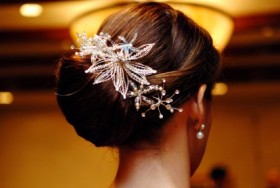Gold, one of the world’s most precious metals, dates back to the dawn of mankind. All civilizations built up to treasuries of the lustrous metal, reserving golden objects for their most important rituals.
However, the most alluring use of the sun-colored metal has always been in jewelry. The Egyptians, largest producers of gold in ancient world, equated gold with the sun, the giver of life, and reserved its use for pharaohs only.
The ancient Etruscans created meticulously handwrought objects using fine granules and threads of gold, a technique still practiced today.
To this day, Chinese and Indian brides wear jewelry of no less than 24-karat gold on their wedding day to ensure a lifetime of good luck and happiness.
And, a gift of gold jewelry says love and permanence as eloquently today as in all the ages past.
The Uniqueness of Gold:
Of all the world’s precious metals, only gold combines the four basic characteristics that make it a universally treasured possession.
Beauty – Gold’s natural color can be further enhanced by alloying it with small amounts of other metals, yielding a spectrum of exquisite, subtle shades. Metalsmiths are able to create yellow, rose, green, and white golds by adjusting the alloys. More copper results in a softer rose color; additional silver creates green gold; and palladium produces white. A popular trend is to combine two or more colors of gold in a single piece of jewelry.
Purity – It is estimated that only slightly more than 100,000 tons of gold have been taken from the earth during all of recorded history. And although gold can be found in rivers, seas and land in many parts of the earth, it is not easily extracted. Opening a mine is a time-consuming and costly operation, and several tons of ore are required in order to produce just one ounce of the precious metal.
Durability – Look no further than the nearest museum where gold jewelry, coins and artifacts from ancient
civilizations attest to the metal’s enduring beauty and permanence.
Workability – Jewelers throughout the ages have preferred gold to all other metals for its beauty and ease of workmanship. Gold can be melted, or shaped, to create any design. It can be alloyed with a number of other metals to increase its strength and produce a variety of colors and can be re-melted and used again to create new designs.
How To Buy Karat Gold Jewelry:
Look for the quality mark. Pure gold, or 24-karat, is generally considered too soft for use in jewelry, so it is alloyed with other metals to increase its strength.
Eighteen-karat gold is 18/24ths, or three-quarters pure gold. Jewelry of this fineness is marked “18K” or “750”, the European designation meaning 75 percent gold.
In United States, 14-karat gold is used most commonly for jewelry. Fourteen-karat gold is 14/24ths, or slightly more than one-half pure gold. Jewelry of this fineness is marked “14k” or “585”, the European designation meaning 58.5 gold.
Nothing less than 10-karat gold can be legally marked or sold as gold jewelry in the United States. These pieces are marked “10k” or “417”, the European designation meaning 41.7 percent gold.
| Karat Marks | 10K | 14K | 18K | 24K |
| European Markings | 417 | 585 | 750 | 999 |
| Percent Pure Gold | 41.7 | 58.5 | 75.0 | 99.9 |
Look for trademarks accompanying the quality mark. When a piece of jewelry is stamped with a quality mark,law requires that it be stamped with a hallmark or trademark as well. Sometimes the jewelry is also marked with its country of origin. These designations are designed to assure you that you are buying genuine gold jewelry of the karatage marked.
Gold come in a variety of colors. Because gold is alloyed with other metals to increase its strength, it can also be made in a variety of colors.
| Metals | Color of Gold |
| Gold, Copper, Silver | Yellow Gold |
| Gold, Platinum or Palladium, Zinc, Copper | White Gold |
| Gold, Silver, Copper, Zinc | Green Gold |
| Gold, Copper, Silver | Roses Gold |
Pricing is based on four factors: karatage, gram weight and craftsmanship.
Caring for Your Gold Jewelry:
Remember that gold is lasting and durable but can get scratched or dented if treated roughly.
Gold’s worst enemy is chlorine. Repeated exposure can weaken gold’s structure, eventually leading to breakage.
Protect your gold jewelry by storing it safely or keeping it wrapped in a soft cloth when not being worn.
Clean your gold jewelry with a cleaning solution of sudsy lukewarm water, or bring it to a jewelry to be steam
cleaned.
Dry and polish with a chamois or soft cloth after cleaning and rinsing.














Stay in Touch